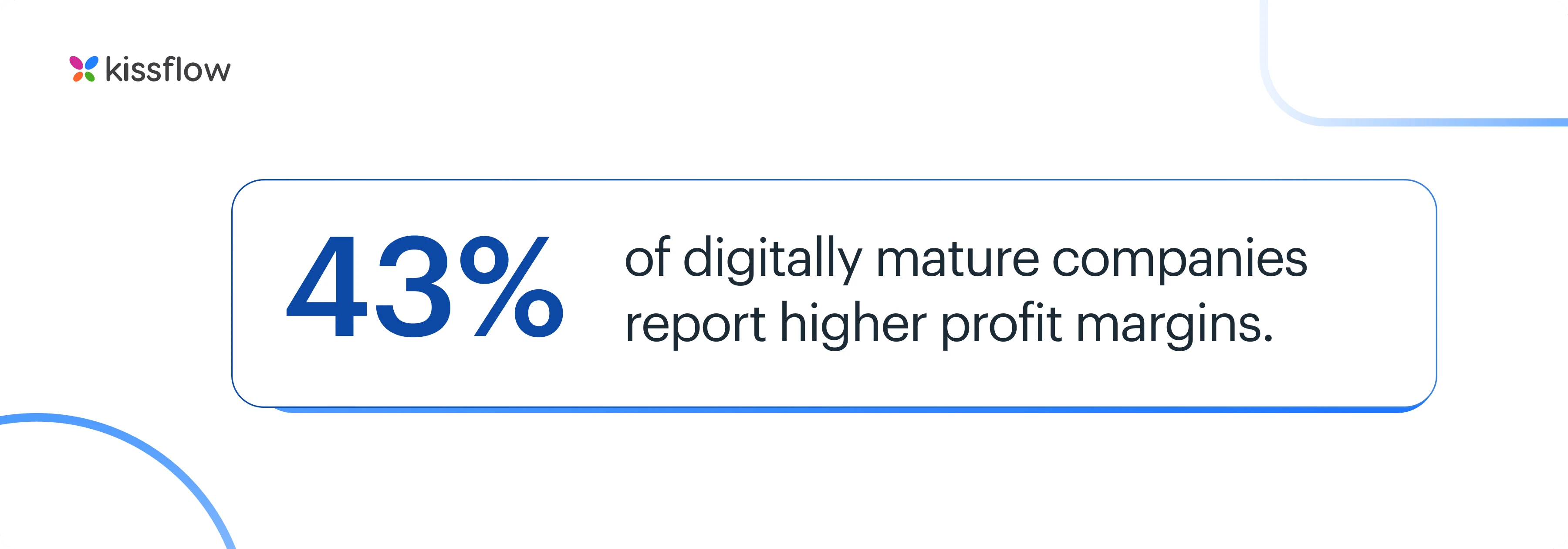
- >
- Digital Transformation >
- Digital Transformation Maturity Model for Every Business
Digital Transformation Maturity Model for Every Business
Team Kissflow
Updated on 8 Apr 2024 • 5 min read
While 91 percent of businesses have engaged in some form of digital initiatives, 70 percent of all digital transformations end up where—which is where the digital maturity model can help.
A digital transformation maturity model is a framework used by enterprises to assess and understand their current level of digital maturity. It helps CIOs plan for growth, measure success, and attain digital maturity goals. The higher a company is on the framework, the more efficient and effective its digital efforts are.
Digital maturity is a measure of an organization's capacity to create value through digital technologies. It is a key determinant of success for companies launching digital transformation initiatives. Organizations that are digitally mature can take on digital transformation not only from a technology standpoint but also through organization-wide efforts. They can use people, processes, and culture to achieve business outcomes.
It’s vital to use the digital maturity model to assess your digital transformation journey because companies with a higher digital maturity level get better business results, thanks to increased digitization. They have better processes, offerings, visions, cultures, and higher revenue. 43 percent of digitally mature companies report higher profit margins.

What is the digital transformation maturity model?
The digital transformation maturity model is a system used by organizations to assess their current level of digital maturity. Its self-assessment helps organizations identify their key strengths and gaps before embarking on a digital transformation journey.
Most companies use BCG’s Digital Acceleration Index to assess and evaluate their digital strengths and weaknesses. It helps them determine how digitally mature they are compared to their competitors, digital leaders, and the industry average.
There are many digital maturity models (DMMs) you can adopt, each with a different approach and focus. But all of them have two things in common: digital maturity stages and a set of dimensions relevant to digital engagement efforts.
Digital transformation maturity models are often influenced by three things:
- Industry specialization: Some models are designed for specific industries to provide better insight and results.
- Scope: Some digital maturity models review an entire organization, helping decision-makers to identify problem areas easily. Others focus on specific areas, allowing for in-depth analysis and a better approach when addressing individual business areas.
- Assessment focus: A digital transformation maturity model may focus on people, processes, and capabilities or on products and services. It all depends on the company’s goals.
Many companies want to digitally transform and do it fast. But in most cases, digital transformation initiatives are rushed because they are driven by the desire to outperform competitors or adopt the latest technology. The end result is usually failure.
When an organization uses a digital maturity model to accelerate its digital transformation efforts, success is inevitable. It is able to identify its strengths and weaknesses and use digital technologies to improve.
In an increasingly volatile marketplace where there is no set timeline for our return to normality, organizations must set clear objectives before adopting any transformational technology.

Digital Transformation Maturity Model Examples
Mckinsey's digital maturity model
McKinsey's metric for a company's digital maturity is called the Digital Quotient. It reveals the digital maturity of an organization by objectively assessing and classifying the digital readiness of individuals, teams, and enterprises. The model comprises four digital maturity stages:
- Strategy
- Culture
- Organization
- Capabilities
TM Forum's Digital Maturity Model
This digital maturity model offers a practical approach to digital transformation. Companies can use it to identify possible investment opportunities and manage the digital transformation journey. TM Forum’s digital maturity model evaluates digital maturity across six business dimensions:
- Customer
- Strategy
- Technology
- Operations
- Culture
- Data
BCG & Google's Digital Maturity Model
This is the most popular digital maturity model created by Google and the Boston Consulting Group (BCG). It demonstrates the importance of data in achieving digital maturity. It measures digital maturity across four stages:
- Nascent
- Emerging
- Connected
- Multi-Moment
What are the stages of the Digital Transformation Maturity Model?
Stage 1: Emerging
This is where organizations that are just getting started in the digital transformation journey are. The two focus areas here are organizational collaboration and establishing trust in data.
Organizations at this stage have lots of data silos. A lack of collaboration between departments characterizes this early phase. Data is only used minimally, therefore its impact is minimal and it can’t be relied on for decision-making.
For example, in an organization, each department may use its own set of digital tools—business intelligence analyzes traffic, marketing produces content, sales delivers it to prospects, and accounting calculates finances. Data has to be manually transferred from one department to another and coordinating cross-departmental processes is difficult.
Stage 2: Developing
At this stage, the decision-makers understand the need for collaboration between departments and support stronger digitalization. Data-sharing, cross-organizational communication, and automating repeatable processes become the norm. Everyone is ready to test and improve business operations with new technologies, and employees are eager to learn how to use data to influence strategic planning.
For example, a company may integrate automation and analytics tools. The business intelligence team sends data to the marketing team, which it uses to create content and marketing campaigns. Lead information is automatically sent to the sales team and accounts receivable pull data from the same platform.
However, a few things fall through the cracks because processes at touchpoints cause a lot of friction. The company has connected data points but still can’t identify the root causes of errors. More work is done but not efficiently and accurately.
Stage 3: Connected
At this stage, there are no isolated departments. Data-driven business processes and interconnected datasets allow the company to link business efforts to outcomes. Data becomes the backbone of the business and can be easily accessed by departments that don’t ‘own’ it. It influences business decisions across organizational processes and functions.
The increasing dependence on data gives birth to project-oriented teams that comprise members of various departments. The company now measures results based on KPIs and metrics. Teams achieve data-driven goals through collaboration. At this point, the company is able to create a digital strategy based on opportunities instead of challenges.
Stage 4: Multi-moment
At the final stage of the digital transformation maturity model, the focus is on building for the future and ongoing improvement. Cross-functional insights are the norm. The organization continuously monitors data and analyzes it to identify opportunities for enhancing digital transformation effectiveness. Digital technologies and capabilities keep evolving.
At this point, the traditional department structure has been replaced by cross-functional workflows and teams. Every touchpoint is measured and all processes are analyzed to track results back to effort. The company uses a digital maturity model framework to recognize opportunities for improvement based on data.
What makes Digitally mature companies great?
Digitally mature companies exhibit many common characteristics. They have a clear, coherent digital strategy, champion collaborative cultures, support cross-functional teams, and plan ahead (five years or 10 years ahead). They also pilot and scale experiments to drive innovation.
Businesses with high digital maturity levels have a competitive advantage across many performance indicators, including time to market, product quality, revenue growth, cost efficiency, and customer satisfaction.
Impact of a digital maturity model on the digital transformation journey
A digital maturity model evaluates a company's current performance and provides a roadmap for digital transformation. If you try to implement digital transformation without first understanding your digital maturity level, you’ll encounter unanticipated roadblocks that will derail your operations, leading to time and money wastage.
The right digital maturity model drives successful digital transformation. Companies use it to benchmark, set direction, and save both time and money. Digital transformation is a process and the path your company takes will be determined by where you are now on the digital maturity model and where you plan to go.
Where are you right now on the digital transformation maturity level?
To determine your digital maturity level, you must answer several questions. Measuring digital maturity lays down the foundation of your digital transformation journey. When you know where you are, it becomes easy to plan where you want to go and know how long it will take to reach your destination. These questions will help you to measure your digital maturity level:
- Does your company have a clear digital transformation strategy and vision in place?
- Does your digital transformation strategy have buy-in across the organization?
- Are all your decisions based on insights derived from data?
- Does your organization have a digital mindset?
- Does your company have the right technology and capabilities?
- Do you create seamless and personalized customer experiences?
- How consistent is your digital experience across different channels?
- How are you going to transform digitally?
- How will you measure the success of your digital transformation initiatives?
Pick the right digital transformation platform
If you want your organization to succeed in today’s digital-first economy, the most important thing you need to do is begin the journey towards becoming digitally mature. A digital maturity model is an effective tool that will provide guidelines for a clear path throughout your digital transformation journey.
Picking the right platform goes a long way in enabling seamless digital transformation.
Kisslow’s low-code platform helps enterprises scale up their digital maturity, measure the right metrics, and take smarter, more informed decisions. With Kissflow, you can digitize and streamline internal processes in your organization, boost collaboration, and increase overall efficiency.
-Apr-08-2024-06-34-59-2050-AM.webp)







